#charles percier
Text
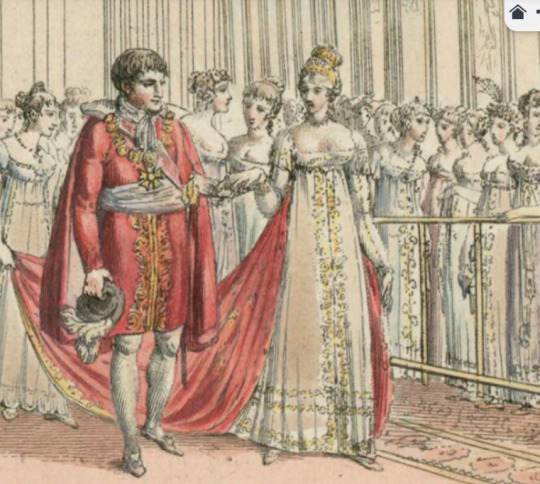
Napoleon marries Marie-Louise
...and some guys who really don't care:

I think this was on BnF Gallica, it's by Percier or Fontaine.
34 notes
·
View notes
Text


Room known as the Empress’ Bedroom at the Grand Trianon in Versailles. Parade bed (1809) created after the design of Charles Percier (1764-1838) by the cabinetmaker Jacob Desmalter (1770-1841) for the imperial bedroom of Napoleon I at the Tuileries Palace from where it was transported to its current location in 1838. It was also the deathbed of Louis XVIII. This bed has been subject to several modifications. Its large escutcheon was altered several times and the layer was enlarged under Louis-Philippe. Original Empire balustrade (1810) by Pierre-Benoît Marcion (1769-1840). Marie-Louise selected the furniture in this room that remains to this day.
#napoleonic era#napoleon#napoleon bonaparte#Versailles#napoleonic#first french empire#19th century#french empire#history#france#bed#grand Trianon#Trianon#Palais des Tuileries#Tuileries#Jacob Desmalter#Jacob-Desmalter#Charles Percier#Percier#Pierre-Benoît Marcion#1800s#empire style#Louis xviii#Napoleon#interiors#interior design#neoclassical
20 notes
·
View notes
Text
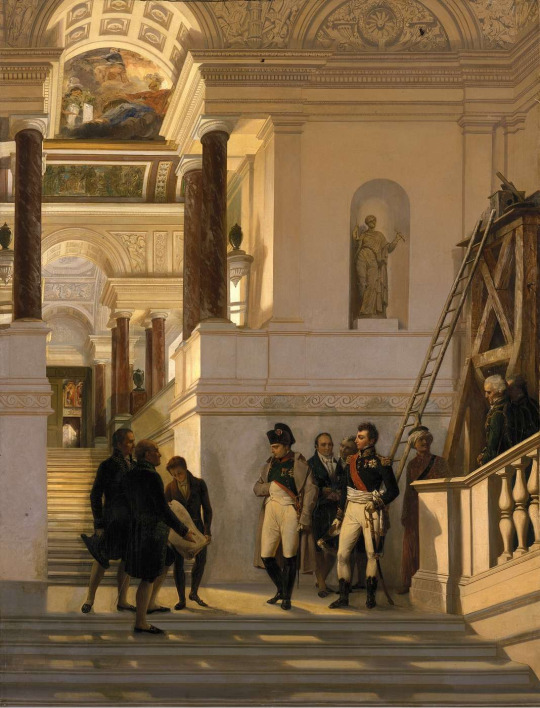
Napoleon visiting the Stairs of the Louvre under the guidance of the architects Percier and Fontaine
by Auguste Couder
#napoléon bonaparte#staircase#escalier#louvre#auguste couder#louvre museum#napoleon#bonaparte#charles percier#pierre fontaine#architects#architecture#paris#france#french#art#history#europe#european#napoleonic#neoclassical#neoclassicism#napoléon#napoleon bonaparte
138 notes
·
View notes
Text


Separating artist, and therefore oeuvre, and biography in contrast to art history still prevails in architectural history, especially with regards to sexual identity and especially so in the German-speaking world. While Philip Johnson in 1996 greeted from the cover of the Gay magazine „Out“ e.g. German postwar heavyweights like Helmut Hentrich or Friedrich Wilhelm Kraemer throughout their lives hid their gayness. This shadowy part of their biographies was the point of departure for Uwe Bresan and Wolfgang Voigt to trace the lives and biographies of gay, lesbian and trans architects. They don’t ask the question of a gay architecture but instead focus on the social, societal and professional surroundings that forced them to hide their sexual identity. In „Gay Architects - Silent Biographies from 18th to 20th Century“ Bresan and Voigt collect 41 biographies ranging from Ernst Georg Sonnin, architect of Hamburg’s famous „Michel“, over Napoleon’s court architects Percier and Fontaine to Paul Rudolph, Horace Gifford and Chen Kuen Lee. With Emilie Winkelmann and Hildegard Schirmacher the authors also included a lesbian and a trans person.
At this point one might argue about the accuracy of the book’s title but in view of the insightful biographical miniatures the authors compiled despite a poor source situation this is negligible. Instead each biography reveals a sometimes less, sometimes more secretive dealing with homosexuality as a result of societal and legal circumstances. In Germany for example Friedrich Wilhelm Kraemer almost lost his chair at TH Braunschweig because in 1950 he had been caught red-handed with a man in a hotel by the police. At this time intercourse between men still was a criminal offence.
An example of outright foul play was the termination of Charles Moore’s tenure as dean of Yale School of Architecture after the university’s committees secretly agreed that Moore was a weak character due to his sexuality.
The latter stories are only two of the 41 told in the book but quite plainly show why it is so important to no longer omit them. Thus the book can only be the starting point for a queer architectural history. An essential and important book!
55 notes
·
View notes
Text

Charles Percier A Roman courtyard seen from a loggia decorated with antique helmets on composite columns and a sarcophagus
black lead, pen and grey ink, grey wash, watercolor on two attached sheets of paper, watermark D&CBlauw
18 x 14 1/4 in. (459 x 364 mm.)
3 notes
·
View notes
Text
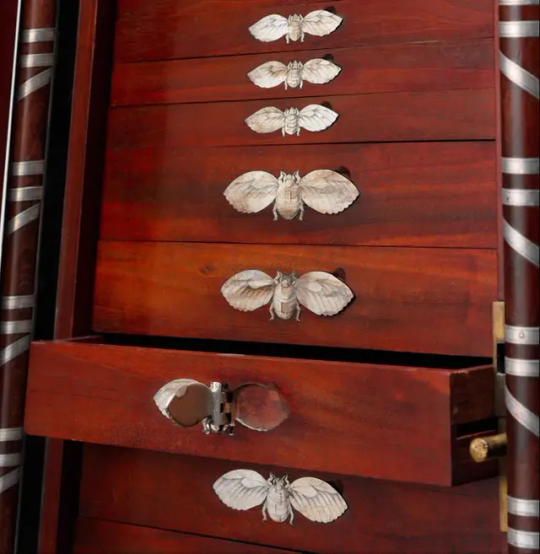


Coin cabinet by Charles Percier, 1809–19. The MET.
3 notes
·
View notes
Photo

Charles Percier
Chalice for the Coronation of Napoleon I, 1804
The Metropolitan Museum of Art
9 notes
·
View notes
Text
El Château de Malmaison, París.
Ubicado a unas pocas millas al oeste de París, fue una vez el hogar de Josefina y Napoleón Bonaparte y, brevemente, la sede del gobierno francés. Josephine compró la venerable propiedad en 1799 mientras su esposo estaba luchando en Egipto. Cuando regresó, contrataron a los arquitectos y decoradores Charles Percier y Pierre François Léonard Fontaine para renovar la casa y los terrenos en ruinas. Josephine recibió la propiedad después de que la pareja se divorciara en 1809 y vivió allí hasta su muerte cinco años después.
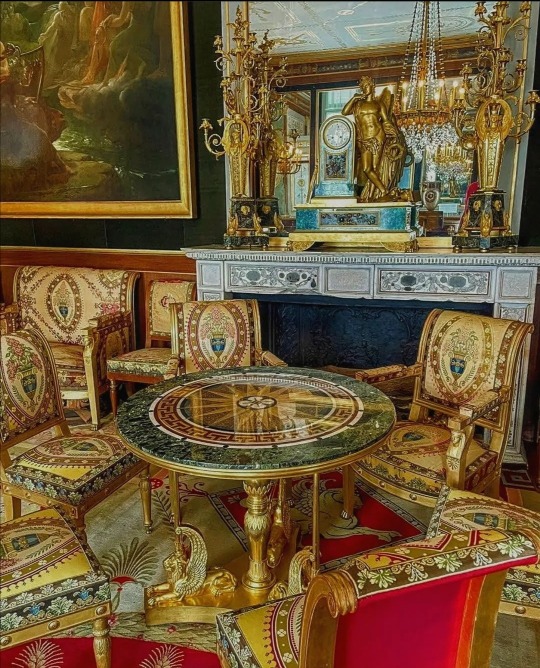
6 notes
·
View notes
Text
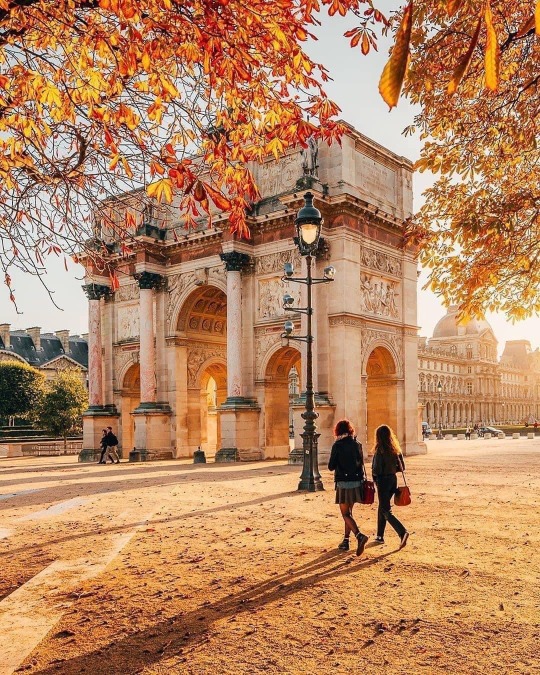
Simplesmente Paris… 🍂🍁🍂🍁🍂
Arco do Triunfo do Carrossel do Louvre.
.
O Arco do Triunfo do Carrossel do Louvre (Arc de Triomphe du Carrousel) fica na mesma linha que o Obelisco de Luxor, na Place de la Concorde, a Avenida dos Champs Elysées, o Arco do Triunfo da Champs Elysées, a Avenida da Grande Armée e o Arco do Triunfo de la Defense.
.
Edificado a mando de Napoleão Bonaparte em homenagem ao seu Grande Exército entre 1807 e 1809, o monumento está localizado diante do Louvre, sobre a esplanada que precedia a ala do Palácio das Tulherias (antes que o palácio fosse queimado, em 1871). Celebrando a vitória dos exércitos franceses na Batalha de Austerlitz, o Arco do Triunfo, desenhado por Charles Percier et Pierre-François-Léonard Fontaine, ilustra a campanha de 1805 e a capitulação de Ulm (cidade localizada na atual Alemanha) em 1807.
1 note
·
View note
Text
Neo-Classical: Gondola Chair

A Gondola chair is a low chair often used at a writing desk, and it comes in different styles.
Compared to the Rococo period, Neo-Classical was less excessive and focused on the simplicity of its geometric forms evident in its interiors and furniture. A lot of the Neo-Classical were inspired by Greek and Roman details. For this plate, we were tasked to do a Gondola chair.
The common feature of this chair is that it has a downward curved back that forms the chair's arms. It was named after the 18th-century Venetian gondola rowboats that had the same curvilinear shape. The chair was to look comfortable, and it was a smaller size, so it was easy to move.
For my reference, the gondola chair is from the late Neo-Classical period, more specifically, the Empire Style. Furniture during this time period was characterized by motifs from Egypt, Rome, and Greece. As well as aggressive elements, like symbols of war and victory, imperial emblems (golden eagle, classical palm leaves, etc.). This specific gondola chair was made by Jacob Frères and designed by architect Charles Percier. It can be seen very familiar Greek and Roman motifs are in the chair, and it has swans as its armrests.
1 note
·
View note
Text
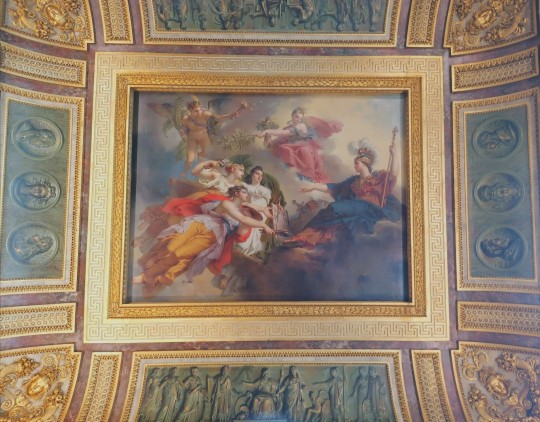
La France sous les traits de Minerve protégeant les Arts, 1819, Charles Meynier, salle Percier, le Louvre Paris France
0 notes
Text

Martin Guillaume Biennais, first Empire, c. 1809
Napoleon I's goldsmith created this vermeil ewer and basin for Joachim Murat, based on a design by Charles Percier.
Source
#Martin Guillaume Biennais#Biennais#Joachim Murat#Murat#1800s#1800s art#artifact#19th century#napoleonic era#french empire#first french empire#napoleonic#art#napoleon#empire style#empire#neoclassical#neoclassical art#neoclassicism#rococo#baroque#decoration#decor#interior#interiors#golden#metalwork#gold#Fontainebleau#royalty
48 notes
·
View notes
Text
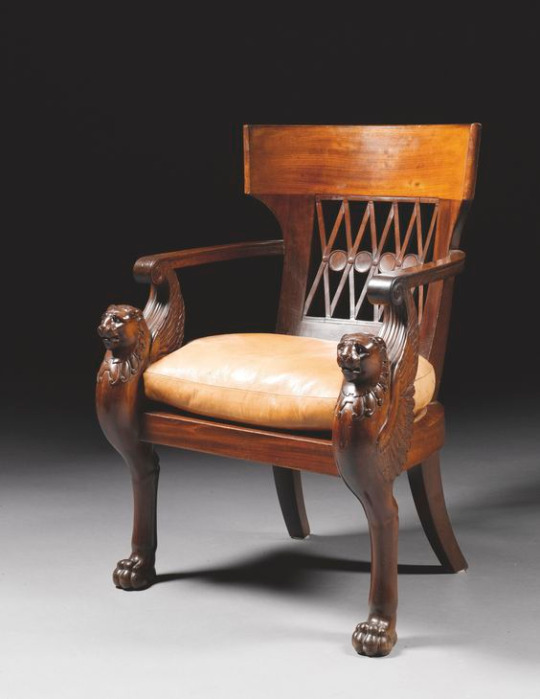
A carved mahogany armchair stamped Jacob Frères, Rue Meslée, after a design by Charles Percier, 1792-97
#carved wood#chair#armchair#gryphon#jacob freres#french design#charles percier#18th century#directoire style
56 notes
·
View notes
Photo
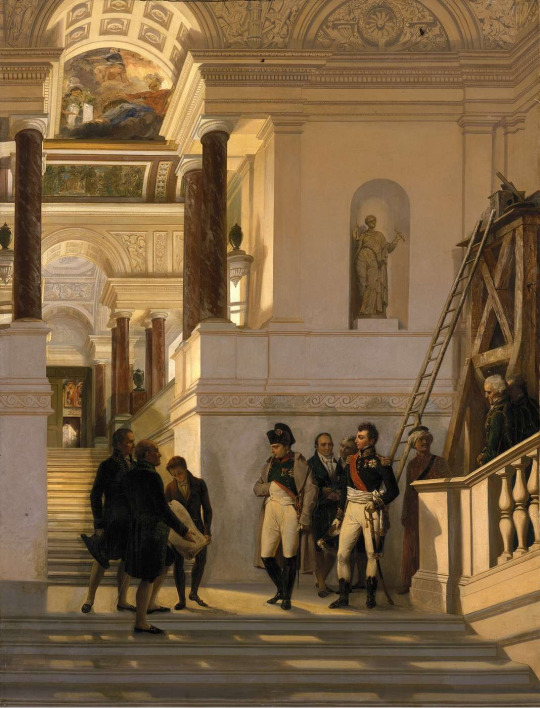
Auguste Couder, Napoléon visitant l'escalier du Louvre avec Percier et Fontaine, oil on canvas, 1833, Musée du Louvre, Paris.
23 notes
·
View notes
Text
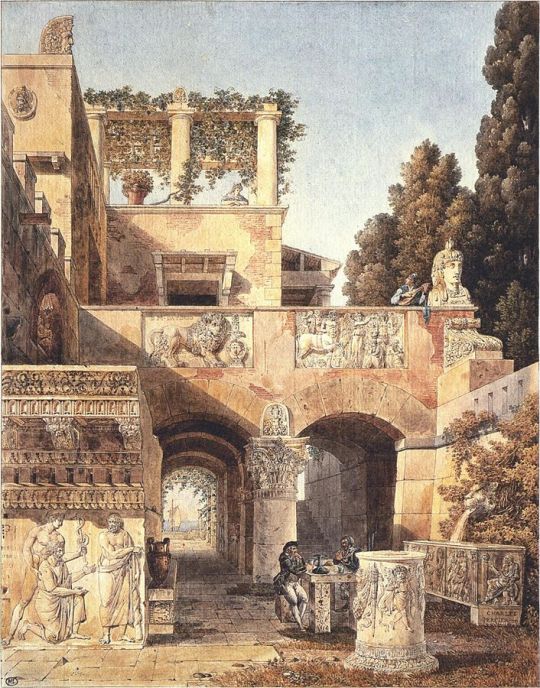
Villa à l'italienne au bord de la mer, 1797 Charles Percier
2 notes
·
View notes
